DIAMONDS 101
Introduction:
Our diamond education page provides you with the most up-to-date information regarding diamond quality and diamond grading. The Gemological Institute of America (GIA) has established the current industry standard for grading and evaluating natural diamonds. As such, all technical information has been obtained directly from; and is attributed to GIA. Photos are also courtesy of GIA. (gia4cs.gia.edu)
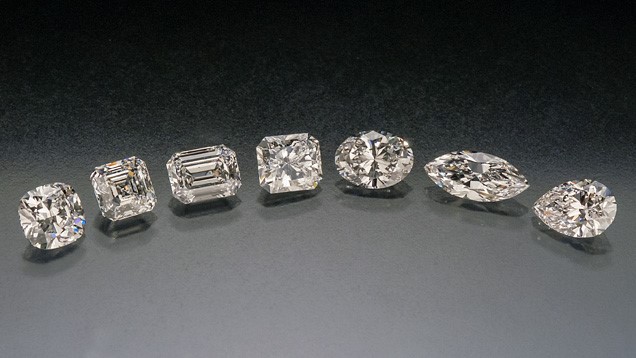
Diamonds are a natural wonder and a rare occurrence. They are also considered to be one of the most beautiful and durable gems on Earth - and no two are exactly the same. It's no wonder they've always been held in such high regard!
While diamonds are indeed rare and beautiful, understanding their quality and grading can sometimes seem confusing and intimidating. Determining which shape, size and quality of diamond to go with can often be a difficult and time-consuming task. Once you get past all this, there are still so many more factors to consider! Relax; we're here to help! (Also see our Diamond-Buying Guide)
We must caution you that high grading does not always guarantee a beautiful diamond; it does however, guarantee an expensive one! You must also use your own eyes by looking at and interacting with diamonds, aided by the assistance of an experienced consultant.
Remember, you don't have to be an expert in quality and grading to know when you're seeing a beautiful diamond! This first-hand approach will also help you to become more familiar with diamonds and will greatly assist you in selecting the right one.
We can certainly help to relieve some of the stress and pressure that can come along with purchasing a diamond. After all, diamonds mark some of the most monumental moments in life. Selecting the right one is very important, but we believe it should also be an enjoyable process for you.
At the Elizabeth Diamond Company, we take both the science and the sale of diamonds very genuinely and very seriously. If you're reading this, then you likely have a few questions about diamond quality, diamond grading, and/or diamond selection.
Please feel free to contact us directly and let our professionally educated staff assist you with all your questions!
Info@shopedc.com 1-866-434-8244 (M-F, 10am-5pm EST)
Be sure to check out the EDC Diamond-Buying Guide to learn even more valuable information; as well as great tips and tricks for selecting the perfect diamond to fit your size, quality and budget needs!
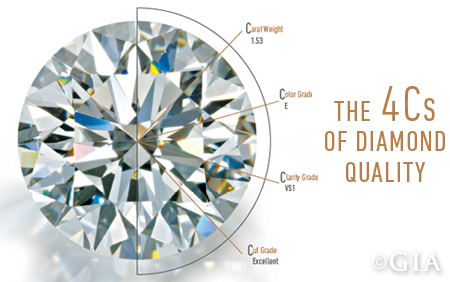
CUT
A diamond's cut can refer to two different things: the actual shape/style of a diamond, as well as the measured accuracy and precision of a diamond's proportions. The cut grade of a diamond is the most important factor in its value and overall beauty. The shape of a diamond is largely a matter of personal choice and is not a factor in grading. To put it simply, we're taking about both shape and sparkle; both of which have a big impact on a diamond's appearance.
Cut Shape:
This refers to the actual shape or style of diamond. There are many options out there, so it helps to determine which will best appeal to the wearer's personality and style. The shape holds no actual bearing on the price or quality of a diamond; however, some shapes are produced less often so there may be fewer options available on the open market.
Here are some descriptions and explanations of the ten most popular and commonly purchased diamond cut shapes:
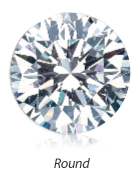
The Round (Brilliant) cut is the most popular diamond shape. It is also considered to be the most traditional. Not only does it fit the natural, rough shape of most diamonds, it is thought to produce more brilliance and sparkle than other cut shapes.
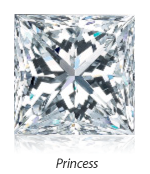
The Princess (Square) cut is also a very popular shape. It is modern, bold and can be very brilliant when cut well. Like the round cut, it also fits the natural rough shape of most diamonds. The most desirable princess cut diamonds are close to perfectly square, with 90° angles at each corner.
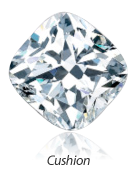
The Cushion cut is a modern adaptation of old-style square brilliant shapes. Its vintage-inspired elegance has become very popular in recent years, making it very desirable for use as an engagement diamond. Soft, rounded corners accent its square - rectangular shape; setting it apart from its round and princess cousins.
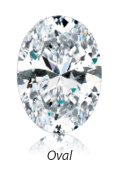
The Oval cut is a direct descendent of the round cut. Traditional and elegant, its elongated shape can present its size very well. While the oval cut is very common among gemstones, it is often only seen in diamond weights of about one carat or more.
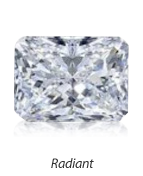
The Radiant cut is a modified square shape, with similar qualities as cushion and princess cut diamonds. It can be square or rectangular in shape; either one may be preferred. A radiant cut diamond can be very brilliant and presents its size well, making it very desirable as an engagement diamond.
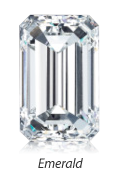
The Emerald cut is by far one of the most unique shapes; largely due to its elongated form and step cuts. Emeralds produce a soft shimmer, as opposed the sparkle of a brilliant-cut diamond. As a result of its unique cut, inclusions and color are much easier to spot with the naked eye. This usually means that a very high grade in both clarity and color is required.
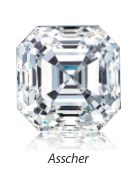
The Asscher cut is a forerunner to the emerald. They are similar to one another; but the Asscher is a square shape with large step facets, a higher crown and much smaller table. Like its elongated contemporary, the Asscher cut is not known for brilliance; however, its more compact shape does allow it to return a higher percentage of light than the emerald. This cut has been gaining in popularity, outnumbering the demand for the emerald cut.
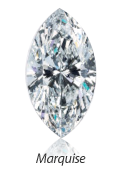
The Marquise cut is an elongated, modified brilliant-cut; and yes, it looks very much like a football - a stunning and shiny football, that is. Because of its pointed ends and its long and sometimes narrow shape, it is very recognizable, especially in heavier weights. Symmetry is very important for this shape to perform well. Carat for carat, the marquise diamond has one of the largest surface areas of any diamond shape, making it a good choice when trying to maximize perceived size.
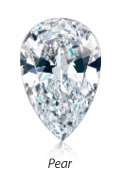
The Pear shape diamond combines a round and marquise shape, with a tapered point at one end. This modified brilliant-cut can be very beautiful in any size, but you can truly see its potential unleashed in very large sizes (typically, 3 carats and above), making it an uncommon diamond shape. Like the marquise cut, proper symmetry is very important for this shape to perform well.
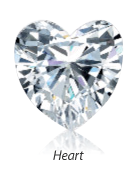
The Heart shape diamond is one of the more unique options. Perfect for romantics, this shape is an unmistakable symbol of love and tends to stand out in a crowd. Heart shaped diamonds smaller than ½ carat are not a usually a good choice because the shape is much more difficult to see when mounted. The heart shape can also appear smaller than it actually is, which has greatly reduced its overall demand.
Cut Quality:
While the cut shape of the diamond you choose largely depends on you and/or the wearer, the cut quality directly effects how much that diamond will sparkle - and of course, everybody loves a beautiful, sparkling diamond!
In fact, the cut quality is the single most important factor in determining a diamond's beauty - and its value! A well-cut diamond will also look slightly larger and be seen from further away than poorly cut diamonds of similar, or even larger sizes.
Think of it like this: if a diamond is cut too shallow, it will look larger than it actually is but perform very poorly. A diamond cut too deep will look smaller and also perform poorly. The ideal proportion allows a diamond to accurately present itself; while maximizing its performance and sparkle.
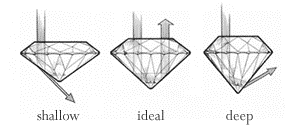
Before we look at the cut grading scale, it helps to know the anatomy of a diamond in order to really understand how the cut grade is measured. Here's a breakdown:
The actual cut grade of the diamond is based on several different factors, considering everything from cut quality to light performance. The cut grade is by far the most technical and most difficult to analyze of all the 4C's. It requires precise measuring of the diamond's facets (the small windows on a diamond), as well as its overall proportions. Each factor is given a grade ranging from poor - excellent. The GIA cut scale below lists each grade from highest to lowest.

These factors are measured to grade the overall quality, accuracy and craftsmanship of the cut:
- Polish - The quality of the polish on each facet of a diamond.
- Symmetry - The quality and accuracy of the overall facet arrangement.
- Proportions - The accuracy of the diamond's individual shape components (table, crown, depth, etc.) and the angles they produce.
Individually, each of these factors can greatly influence a diamond's ability to return light. For instance, if a diamond's symmetry and proportions are excellent, but its polish is poor, it will not produce much sparkle.
This is one reason that shoppers greatly benefit from visiting a trusted, professional jewelry and diamond store and taking the eye test first hand. You don't need to be a diamond expert to see sparkle or know what it is. Give yourself the opportunity to view multiple diamonds, side by side; to see the difference a well cut, hand selected stone can make.
While you can always recognize a diamond's sparkle, you may still wish to see some type of grading or analysis of a particular diamond's light return, possibly if comparing two similar stones. Thanks to advancing technology within the industry, we have the ability to analyze and map diamond's light performance.
These factors are considered when analyzing the overall light performance of a diamond:
- Brightness - The internal & external white light reflected from a diamond.
- Fire - The dispersion of white light into the spectral colors of the rainbow.
- Scintillation - The overall amount of sparkle a diamond produces.
As you can see, determining a diamond's cut grade is a very complicated process. The good news is, you don't actually have to measure it yourself! All you really have to do is look at a diamond to see its sparkle.
COLOR
The diamond color evaluation of most gem-quality diamonds is actually based on the absence of color. A chemically pure and structurally perfect diamond has no hue, like clear, distliied water; and consequently, a higher value.
GIA's D-to-Z diamond color-grading system measures the degree of colorlessness by comparing a stone under controlled lighting and precise viewing conditions to master stones of established color value.
GIA's diamond color-grading scale is the industry's most widely accepted grading system. The scale begins with the letter D, representing colorless, and continues with increasing presence of color, to the letter Z.

Many of these color distinctions are so subtle that they are invisible to the untrained eye; however, these distinctions make a very big difference in diamond quality and price.
Most diamonds purchased for rings tend to be in the range of colorless to near colorless. In this range, color is either undetectable or extremely faint when mounted into a ring.
CLARITY
Natural diamonds are the result of carbon exposed to tremendous heat and pressure deep in the earth. This process can result in a variety of internal characteristics called 'inclusions' and external characteristics called 'blemishes.'
Evaluating diamond clarity involves determining the number, size, relief, nature, and position of these characteristics, as well as how these affect the overall appearance of the stone. While no diamond is perfectly pure, the closer it comes, the higher its value.
Gem quality diamonds are graded from Flawless (highest) down to Imperfect (lowest). Here is the GIA clarity grading scale:
The grading of a diamond's clarity occurs under 10X magnification, allowing the grader to see into each facet of the diamond. It is important to note that diamonds graded from Slightly Included and above usually appear as essentially flawless to the naked eye.

Below are some examples of how inclusions may present themselves within the various GIA clarity grades (under 10X magnification).

CARAT WEIGHT
Diamond carat weight is the measurement of how much a diamond weighs. A metric "carat" is defined as 200 milligrams.
Each carat can be subdivided into 100 'points.' This allows very precise measurements to the hundredth decimal place. A jeweler may describe the weight of a diamond below one carat by its 'points' alone. For instance, the jeweler may refer to a diamond that weighs 0.25 carats as a 'twenty-five pointer.' Diamond weights greater than one carat are expressed in carats and decimals. A 1.08 carat stone would be described as 'one point zero eight carats.' Here are some examples to give you an approximation of size relative to diamond carat weight:

All else being equal, diamond price increases with diamond carat weight because larger diamonds are more rare and more desirable. But two diamonds of equal carat weight can have very different values (and prices) depending on three other factors of the diamond 4Cs: Cut, Color and Clarity.
It's important to remember that a diamond's value is determined using all of the 4Cs, not just carat weight.
DIAMOND CARE
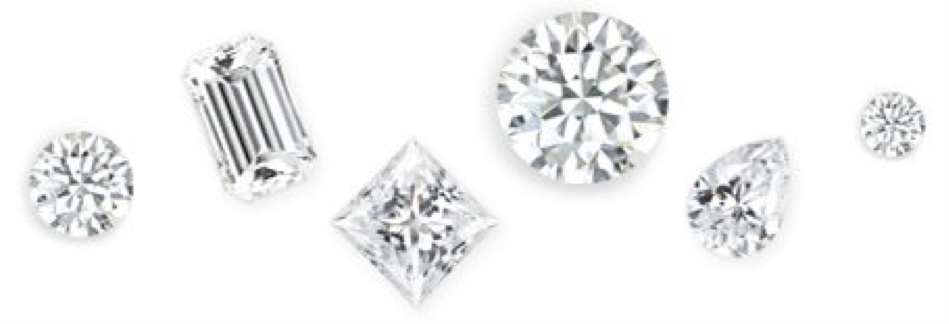
TAKING CARE OF YOUR DIAMOND:
Although your diamond is one of the hardest natural materials on earth, you still want to look after it with great care.
STORING YOUR DIAMOND JEWELRY:
Always store your diamond in its box when you are not wearing it. While diamonds are one of the hardest natural materials known to man, they are not the toughest.
Diamonds can be damaged or scratched. In fact, diamonds can scratch other diamonds; not to mention gold, platinum and gemstones, so it is best to store them away from other jewelry items.
INSURING YOUR DIAMOND:
Your diamond holds a lifetime of dreams, memories and promises. For your peace of mind, it is recommended that you insure your diamond through a trusted insurance provider.
Some certified diamonds, such as those from Forevermark, can be registered for additional assurance.
As an added precaution, have your diamond and setting checked for wear and tear on a regular basis. This can help to prevent stone loss by ensuring that your diamond settings are in good repair. Many jewelers offer free cleaning and inspection services; some jewelers, like EDC, are equipped with on-site jewelry repair services to maintain your treasured items.
CLEANING YOUR DIAMOND:
A diamond's brilliance depends on the amount of light that enters it, so cleaning your diamond will keep it as bright and brilliant as the day you received it. Diamonds naturally pick up oil and grease, so to maintain its sparkle you should clean your diamond regularly - daily if possible. A basic liquid jewelry cleaner - often found in jewelry and department stores, can remove surface impurities that build up from daily wear.
Always ensure that the type of cleaner is appropriate for your item(s) and be sure to read the instructions carefully before use.
For intense, detailed cleaning, we recommend that you have your diamond professionally cleaned by a trusted jeweler. Most jewelers will have ultra-sonic jewelry cleaners, which emit high-frequency sonic waves in order to thoroughly clean under stone settings and other areas that are difficult to reach. Often, jewelers will use pressurized steam to remove water spots and to bring your diamond back to a dazzling brilliance.
DIAMOND IMMEASURABLES
You know the 4C's of a diamond (Cut, Color, Clarity & Carat Weight) and while that is very important, there's so much more to the story…
It is widely known that no two diamonds are exactly alike. These differences involve factors that lie outside of the diamond grading process; however they can impact a diamond's beauty just as much as each of the 4C's.
For instance, some diamond crystals are naturally brighter than others. A whiter, brighter crystal will produce a brighter finished diamond.
Compare two diamonds of ideal proportions, with similar overall grading. While you may see two brilliant, sparkling diamonds, the overall hue of one diamond's body may appear to be much brighter.
No matter how high the graded quality of a diamond may be, it still has to deliver in terms of the overall look and beauty. After all, you don't wear the grading report; you wear the diamond!
At the Elizabeth Diamond Company, we firmly believe that the sourcing (area of origin) of a diamond is a serious matter as well as a key component to its beauty. Think of it in terms of fine wine. Ultimately, it doesn't matter how superior the fermentation and production process, if the grape itself is inferior to other regions it will not produce a superior wine.
Of the many factors that make diamonds unique from each other, the source area plays a major role in the overall quality of the rough diamond material. That's why EDC chooses to hand select our vast, in store diamond inventory from the finest, brightest natural Russian diamond crystals.
We are also proud to have been chosen as an authorized dealer and partner of Forevermark Diamonds. These superbly brilliant diamonds are not only cut from the best quality diamond material available, they are ALWAYS responsibly sourced.
We believe in offering better quality diamonds that will always impress. This philosophy has led us to look at so much more than just the 4C's when hand selecting exceptional diamonds for our customers. That's why EDC diamonds always stand out from the rest! To see a real-life example of this, check out the EDC Diamond Challenge on the About Us page.

